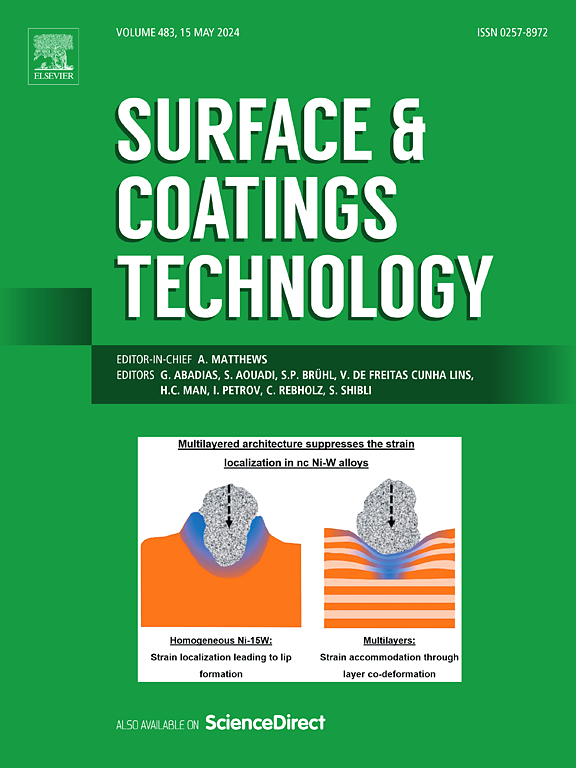基于激光纹理的仿生光热超疏水表面,具有良好的防/除冰性能和耐久性
IF 5.3
2区 材料科学
Q1 MATERIALS SCIENCE, COATINGS & FILMS
引用次数: 0
摘要
光热超疏水表面以其节能环保的特点在防除冰领域引起了广泛的关注。然而,它的制备通常使用光热材料,这意味着更高的成本或繁琐的合成步骤。本研究以斜纹夜蛾(Spodoptera litura)复眼的结构特点和光热特性为灵感,以高压线用1060铝材料为研究对象,仅通过激光变形和聚二甲基硅氧烷(PDMS)的化学改性,制备了一种新型光热超疏水表面。表面具有微米级无底(>100 μm)六角形凹坑阵列结构,表面覆盖一层纳米级颗粒,促进了微纳复合结构内部光的多次反射,有效提高了表面的光热性能。同时,粗糙的表面结构和较低的表面能使表面具有较强的超疏水性,与抛光表面相比,可以显著延迟液滴的冻结时间。这两种性质的协同作用可以使冰面的冰块迅速融化和滑动。而且,经过一定程度的耐久性试验,表面仍能保持优异的光热性能和超疏水性能。可以预期,由于快速和直接的制备,优越的抗/除冰性能,值得称道的耐久性和环境可持续性,该表面在实际应用中具有广泛的发展范围。本文章由计算机程序翻译,如有差异,请以英文原文为准。

Bio-inspired photothermal superhydrophobic surface with good anti-/de-icing property and durability based on laser texturing
The photothermal superhydrophobic surface has attracted wide attention in the field of anti‐/de-icing due to its energy-saving and environmental protection characteristics. However, its preparation often uses photothermal materials, which means higher costs or cumbersome synthesis steps. In this study, inspired by the structural characteristic and photothermal property of the compound eye of Spodoptera litura, a novel photothermal superhydrophobic surface was prepared by using 1060 aluminum material for high voltage lines as the research object, only through laser texturing and chemical modification with polydimethylsiloxane (PDMS). The surface has a bottomless (>100 μm) hexagonal pit array structure at the micron level, and the surface is covered with a layer of nanoscale particles, promoting multiple reflections of light inside the micro-nano composite structure, effectively improving the photothermal performance of the surface. Meanwhile, the rough structure and low surface energy give the surface a strong superhydrophobic property, which can significantly delay the freezing time of droplets compared with the polished surface. The synergistic effect of the two properties can make the surface's ice blocks melt and slide rapidly. Moreover, after a certain degree of durability test, the surface can still maintain excellent photothermal and superhydrophobic performance. It can be expected that the surface has a wide scope of development in practical applications due to rapid and straightforward preparation, superior anti‐/de-icing property, commendable durability, and environmental sustainability.
求助全文
通过发布文献求助,成功后即可免费获取论文全文。
去求助
来源期刊

Surface & Coatings Technology
工程技术-材料科学:膜
CiteScore
10.00
自引率
11.10%
发文量
921
审稿时长
19 days
期刊介绍:
Surface and Coatings Technology is an international archival journal publishing scientific papers on significant developments in surface and interface engineering to modify and improve the surface properties of materials for protection in demanding contact conditions or aggressive environments, or for enhanced functional performance. Contributions range from original scientific articles concerned with fundamental and applied aspects of research or direct applications of metallic, inorganic, organic and composite coatings, to invited reviews of current technology in specific areas. Papers submitted to this journal are expected to be in line with the following aspects in processes, and properties/performance:
A. Processes: Physical and chemical vapour deposition techniques, thermal and plasma spraying, surface modification by directed energy techniques such as ion, electron and laser beams, thermo-chemical treatment, wet chemical and electrochemical processes such as plating, sol-gel coating, anodization, plasma electrolytic oxidation, etc., but excluding painting.
B. Properties/performance: friction performance, wear resistance (e.g., abrasion, erosion, fretting, etc), corrosion and oxidation resistance, thermal protection, diffusion resistance, hydrophilicity/hydrophobicity, and properties relevant to smart materials behaviour and enhanced multifunctional performance for environmental, energy and medical applications, but excluding device aspects.
 求助内容:
求助内容: 应助结果提醒方式:
应助结果提醒方式:


